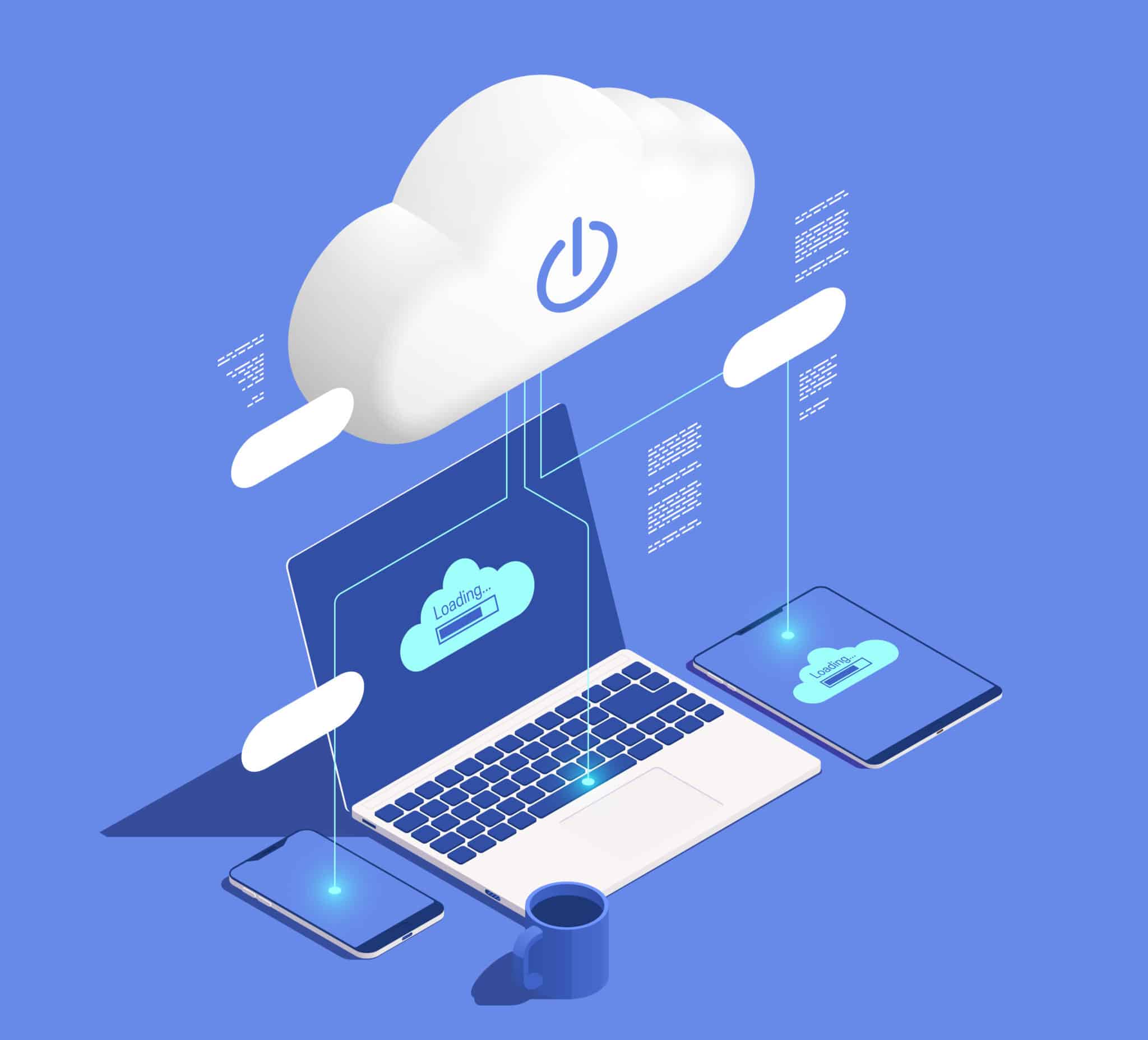Your Guide To a Successful Cloud Adoption Framework
Since the early 2010s, cloud adoption for many businesses has been considered a sort of ‘keeping up with the Joneses’ for the tech world. Yes, everyone is doing it. Yes, cloud-based infrastructure is powerful. And yes, it’s high on the to-do list of every CTO.
But recently, the conversation around actually moving from on-prem to cloud or hybrid-cloud systems has shifted gears from being a preferred mode of operation to somewhat of a necessity.
Most industry leaders now agree that by 2028, having your data and applications in the cloud will be business-critical.
Leaping head-first into the cloud without a clear strategy—or framework—is like building a skyscraper without any blueprints. It’s going to be costly, risky, and probably fall over at the first sight of trouble.
Having a well-structured cloud adoption framework to shift your business systems into the cloud is a methodical approach that helps build something sustainable, scalable, and ready for the future once you’ve arrived.
The Big Leap: What Is a Cloud Adoption Framework, Really?

When you hear “cloud adoption,” it’s really easy to picture a few workloads and online connectors and call it a day. But true cloud adoption isn’t a quick fix, it’s a strategy.
Cloud adoption frameworks are the blueprints and roadmaps for a transformation, ensuring that all pieces of your corporate puzzle fit together, from technology to people and processes.
Without it, cloud initiatives often fail, overwhelmed by the sheer complexity of it all and goals that weren’t exactly clear in the first place.
Cloud Adoption vs. Cloud Migration: Not the Same Thing

Adoption and migration aren’t synonyms, but they’re often used interchangeably. Cloud migration is the act of moving your existing systems and applications to the cloud. Cloud adoption, however, goes way deeper.
Adoption is the process and decision to wholeheartedly embrace cloud technologies, and reshape your business model, culture, IT infrastructure, and processes to fully leverage the potential of the cloud.
Why a Framework Matters More Than a Plan
A plan gets you started, but a framework is what keeps you moving forward no matter how tough it gets (and it will get tough).
Those at the helm making big IT decisions need a comprehensive cloud adoption framework to navigate the technical aspects and monumental organizational shifts required.
It’s easy to think you’re just shifting servers, but in reality, you need to align the entire business to thrive in the cloud-driven direction you’re taking.
To Cloud or Not To Cloud? Questions Every Tech Leader Should Ask First
Before diving into cloud adoption, pause and ask the right questions first. Yes, the cloud offers endless opportunities, but that doesn’t mean it’s one-size-fits-all, and it certainly doesn’t mean there’s enough room for what you’ve got running on-premises.
Understanding your unique needs and current infrastructure first is crucial. It will help you determine whether moving to the cloud is going to be a success or a costly experiment.
What’s Your Endgame?
What are you hoping to achieve with cloud adoption?
Are you looking to drive innovation, scale your operations, or maybe cut costs?
Maybe it’s all of these things and more. Either way, you need to define your business strategic objectives upfront when developing your cloud adoption strategy.
They should align with your overall goals and the goals of the business. Moving to the cloud should drive business growth instead of hindering it.
What’s on the Line?
Is your existing infrastructure cloud-ready? It’s a simple question with a not-so-simple answer.
Evaluating your operational readiness is one of the most important questions to ask when formulating your framework for cloud adoption.
- Do you have the network bandwidth?
- Is your team skilled in the right areas?
- Will you need to outsource?
- Can your mission-critical production applications be hosted in the cloud?
- Can your applications be virtualized?
- Where can your data be stored?
- Are there data privacy and sovereignty requirements?
Every single piece must be cloud-compatible. If not, it’s time to upgrade before you make the leap.
Building the Framework: Developing Your Blueprint for Success
Once you have decided on full cloud adoption, it’s time to get serious about building a framework that can sustain long-term success.
Unless you’re happy to rebuild from scratch, the adoption process isn’t quite as easy as your vendors would like you to believe. There’s a lot of moving parts, even more data, and a huge maze of compliance to navigate.
Building a framework requires a well-thought-out strategy with a lot of nuance, and it should account for your organization’s unique needs and feature goals.
Let’s break it down, step-by-step.
Step 1: Laying the Foundation
Before you start thinking about scaling, automation, and all the exciting facets of cloud adoption, you need to establish a solid foundation.
Understanding Your Current State
Are you still rooted in an on-premise setup, relying on a hybrid model, or ready for the full cloud-native solution?
Moving from a dedicated premises will require a lot more groundwork than transitioning from a hybrid environment with some infrastructure already in place, while a cloud-native approach might mean re-thinking your architecture entirely.
Evaluate your current systems, applications, and workflows to see how well they map to cloud infrastructure models:
| Cloud Setup | Definition | Pros | Cons |
| On-Premise | Infrastructure managed entirely on your own hardware and data centers. | Full control over data and infrastructure. | High upfront costs, limited scalability. |
| Hybrid Cloud | Combines on-premise infrastructure with cloud services, using both environments. | Flexibility, allows gradual transition to cloud. | Complex to manage, potential integration challenges. |
| Cloud-Native | Fully utilizes cloud services, designed for scalability and flexibility. | Highly scalable, cost-effective, flexible. | Requires a complete shift in architecture, team skills, and mindset. |
Building a Cloud-Ready Culture
While it’s easy to get caught up in the technology side of cloud adoption, you need to consider your people and processes, too.
A cloud-ready culture means fostering an agile and resilient mindset amongst the entire workforce, from ITSD to HR and staff in the field. Everyone in the organizational structure is affected, so strong and flexible leaders will be needed to manage the change.
Training teams, redefining workflows, and encouraging cross-departmental collaboration are all critical to the long-term success of the transformation.
Cloud-ready workplace cultures are aligned with the new flexibility and pace of cloud infrastructure and can adapt to the new processes once in place.
Step 2: The Four Pillars of Cloud Adoption
With your foundation firmly in place, it’s time to start building the framework. Every single successful cloud adoption strategy rests on these four key pillars:
- Governance
- Security
- Cost Management
- Resiliency
Let’s take a look at them in more detail:
Governance – The Cloud Resources Watchdog
Governance ensures your cloud environment doesn’t turn into a sprawling and unruly mess. Define aspects like resource allocation, policy enforcement, and compliance with industry and government regulations.
This is where policies around data access, user permissions, and overall resource management will be mapped out in advance.
Without proper governance, cloud sprawl can lead to inefficiency at best—and security risks at worst.
Security – The Proactive Approach
In the cloud, security can’t be an afterthought. A proactive security approach means designing with data integrity and threat mitigation in mind, not just reacting when something goes wrong.
Establish encryption standards, both data at rest and transit, monitor for anomalies, and ensure identity systems are strong.
When moving out of the relative safety of on-prem firewalls and air gaps, it’s not just your internal standards you’ll need to comply with. You now need to adhere to regulations, guidelines, and laws such as:
- SOC2 – System and Organization Controls (SOC) Reporting
- GDPR – General Data Protection Regulation
- HIPAA – Health Insurance Portability and Accountability Act
- CSA STAR – Security Trust Assurance and Risk
- FISMA – Federal Information Security Modernization Act
- PCI DSS – The Payment Card Industry Data Security Standard
It’s important to know which of these regulations apply to your industry and understand how to be compliant.
Cost Management – Keeping Cloud Economics Under Control
The pay-as-you-go nature of the cloud is a double-edged sword. While you avoid the big upfront costs, the ongoing operations expenses can spiral out of control if you don’t rein them in and put in tight controls.
Here, you need to deploy cost-tracking tools, set budget thresholds, and clearly optimize your resource usage—all parts of a cost management strategy.
You will need to balance performance and cost to avoid surprises that can quickly derail your cloud adoption efforts.
Resiliency – Plan for the Unplannable
Things can and will go wrong—sometimes, catastrophically. This is exactly why resilience is a core pillar of cloud adoption.
Continually planning so that your business can weather any storm through disaster recovery, penetration testing, backups, and simulated exercises can help prepare for cyber attacks, natural disasters, and plain old service outages.
While cloud-native tools do make this process easier with automated failovers, backup solutions, and distributed architecture, you’ll still need to implement the same development, test, and production environments you had with on-prem to keep your organization running, no matter what.
Step 3: Scaling with Confidence
Adoption doesn’t stop just because you have made a successful transition to the cloud. The cloud is constantly evolving, and your business and its framework must evolve alongside it.
Continuous improvement, whether through auditing, feedback loops, or optimization strategies, ensures your cloud infrastructure is always performing at its best.
When new technologies emerge—and they will, your framework must be flexible enough to integrate them without a lot of disruption.
Common Pitfalls in Cloud Adoption (and How To Avoid Them)
Even if your cloud adoption framework is rock solid, there are still plenty of gotchas and common mistakes that trip up even the most prepared organizations.
Here’s what to watch out for and how to avoid costly blowouts:
1. Misjudging Costs and Underestimating Cloud Complexities
As mentioned earlier, pay-as-you-go payment models might seem budget-friendly, but ask anyone who has had to deal with SAP or ESX pricing models – hidden costs quickly pile up.
You don’t need to predict the future, but avoid surprises by forecasting your expenses and using cost management tools to monitor resource and storage usage.
2. Failing to Properly Manage Change Within the Organization
This is a big one and easy for tech leaders to overlook. Cloud adoption isn’t just a technical shift, it’s a cultural one, too. For some it might mean getting used to a new interface. For others, it could mean their role is no longer required. It’s a change that affects everyone, and not always to the same degree.
Failing to properly prepare the organization for change means resistance and bottlenecks when it’s time to cut over. Invest in training and clear communications to ease the transition.
3. Overlooking the Importance of Governance and Security
Just because your new environment is shiny and new, doesn’t mean it won’t quickly start to sprawl, or that access control won’t end up so complicated that individual rules start creeping back in again.
Put policies in place early and enforce them. Audit things regularly, have every policy documented clearly, and appoint teams to manage the records.
Future-Proof Your Cloud Strategy with KMS Technology
A robust and adaptable cloud adoption framework is your cornerstone of long-term success. Remember that it’s not just about getting to the cloud (although this is a huge part of it). It’s about thriving once you’re there.
With these steps in place, your cloud adoption framework will be so much more than a roadmap—it will be a living, breathing strategy capable of driving your organization’s future success.
At KMS Technologies, we specialize in deploying teams that help organizations just like yours build and implement cloud adoption frameworks, and facilitate cloud and data migration.
From strategic planning to seamless execution, we have data engineers, software developers, project managers, and consultants to guide you every step of the way.
Contact KMS technology today to future-proof your cloud strategy and unlock the full potential of your cloud journey.








